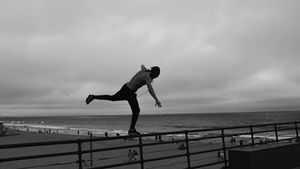Perturbation-Based Balance Training
Introduction[edit | edit source]
Perturbation-based balance training (PBT) is a form of training that aims to improve reactive balance control after unexpected external perturbations. It is an intervention involving repeated postural perturbations aiming to improve control of rapid balance reactions. PBT potentially leads to fewer falls and improved clinical outcomes.
- In a safe and controlled environment, participants are repeatedly exposed to destabilizing perturbations during various activities of daily living. Many different training setups can be utilized, from fairly simple lean-and-release perturbations requiring only a safety harness, to advanced systems that can provide a wide variety of perturbation types and intensities during various tasks.
- Balance boards are often incorporated in perturbation based balance training.
- Besides improving balance and reducing falls incidence, PBT can significantly reduce the fear of falling. Fear of falling can have a major impact on older adults.[1]
Clinical Application[edit | edit source]
Adaptation may occur faster PBT than with conventional balance training, offering the potential of achieving equal or better results with fewer training sessions[1]
Studies of PBT have shown significant reductions in falls in older adults and in those with specific disorders eg Parkinson’s disease or stroke compared to various control groups).
- A recent systematic review found that this form of training helped to reduce risk of falling in elderly adults and those with Parkinsons disease.[2]
- Perturbation/balance exercises improve by Osteoarthritis (OA) knee clients via improving function, and balance and reducing pain.[3] PBT has the additive positive effects of kinesthesia and increases their functional capacities.[4]
- Ankle instability. Once pain-free range of motion and weight bearing have been established, balance-training exercises should be incorporated in ankle instability/acute sprain to normalise neuromuscular control.[5] A 2018 systematic review on bracing and balance training on rate of ankle sprains concluded that moderate quality evidence for balance training to decrease the incidence and reduce the relative risk of ankle sprains in competitive athletes.[6]
Examples[edit | edit source]
Some examples of these techniques are shown in video below
Other examples are outlined below
- Double-Leg Foam Balance Activity: Subject stands on a soft foam surface with both feet on the ground. Therapist attempts to perturb patient balance in random fashion. Exercise dosage/progression: The duration of the activity is approximately 30 seconds.The difficulty is progressed as the subject improves by progressing to ball catching with therapist perturbing subject’s balance while standing on foam and progressing to single-leg support if tolerated without knee pain, swelling, or buckling.
- Tilt board Balance Training: The subject stands on a tilt board or balance board with both feet on the board. The therapist perturbs the tilt board in forward and backward and side-to-side directions for approximately 30 seconds each. Exercise dosage/progression: The difficulty of the activity is progressed by adding ball catching during the perturbations and progressing to single-limb support perturbations if the subject tolerates single-limb weight bearing without knee pain, swelling, or buckling.
- Roller board and Platform Perturbations: The subject stands with one limb on a stationary platform and the other limb on a roller board. Therapist perturbs roller board in multiple directions, at random, and the subject attempts to resist the perturbations. The activity lasts approximately 30 seconds. The activity is repeated by changing the limbs on the platform and the roller board. Exercise dosage/progression: The activity may begin with subject in the semi-seated position, with hips resting on plinth if the subject has difficulty doing the activity in full standing. The activity is progressed to the full standing position when the subject is able to tolerate this position without pain.
The video below shows use of perturbation activities for ankle instability
Outcome Measures[edit | edit source]
PBT involves repetitive exposure to balance perturbations during standing and walking tasks. The goal for participants is to achieve improved control of reactive stepping (eg, faster reaction time). One method of assessing reactive balance is called the Lean-and-Release test, which simulates a forward fall in a safe environment.[9]
Push and Release test: Assessed postural instability and may assist in identifying patients with balance impairments before they experience a fall.
References[edit | edit source]
- ↑ 1.0 1.1 Gerards MH, Marcellis RG, Poeze M, Lenssen AF, Meijer K, de Bie RA. Perturbation-based balance training to improve balance control and reduce falls in older adults–study protocol for a randomized controlled trial. BMC geriatrics. 2021 Dec;21(1):1-2.https://bmcgeriatr.biomedcentral.com/articles/10.1186/s12877-020-01944-7 (accessed 14.4.2021)
- ↑ Avril Mansfield, Jennifer S. Wong, Jessica Bryce, Svetlana Knorr, Kara K. Patterson, Does Perturbation-Based Balance Training Prevent Falls? Systematic Review and Meta-Analysis of Preliminary Randomized Controlled Trials, Physical Therapy, Volume 95, Issue 5, 1 May 2015, Pages 700–709, Available from: https://academic.oup.com/ptj/article/95/5/700/2686424 (last accessed 29.4.2019)
- ↑ Rhon D, Deyle G, Gill N, Rendeiro D. Manual physical therapy and perturbation exercises in knee osteoarthritis. Journal of Manual & Manipulative Therapy. 2013 Nov 1;21(4):220-8. Available from: https://www.ncbi.nlm.nih.gov/pmc/articles/PMC3822322/ (last accessed 1.5.2019)
- ↑ Diracoglu D, Aydin R, Baskent A, Celik A. Effects of kinesthesia and balance exercises in knee osteoarthritis. JCR: Journal of Clinical Rheumatology. 2005 Dec 1;11(6):303-10. Available from: https://www.ncbi.nlm.nih.gov/pubmed/16371799 (last accessed 1.5.2019)
- ↑ Mattacola CG, Dwyer MK. Rehabilitation of the ankle after acute sprain or chronic instability. Journal of athletic training. 2002 Oct;37(4):413. Available from: https://www.ncbi.nlm.nih.gov/pmc/articles/PMC164373/ (last accessed 1.5.2019)
- ↑ Bellows R, Wong CK. THE EFFECT OF BRACING AND BALANCE TRAINING ON ANKLE SPRAIN INCIDENCE AMONG ATHLETES: A SYSTEMATIC REVIEW WITH META-ANALYSIS. International journal of sports physical therapy. 2018 Jun;13(3):379. Available from: https://www.ncbi.nlm.nih.gov/pmc/articles/PMC164373/ (last accessed 1.5.2019)
- ↑ Jo La Kasa del Noh. Balance and pertubations. Available from: https://www.youtube.com/watch?v=zX9o7CfusqM (last accessed 29.4.2019)
- ↑ Union phyiotherapy. Ankle stability. Available from: https://www.youtube.com/watch?v=JhQnWHmaXpg (last accessed 1.5.2019)
- ↑ Unger J, Chan K, Scovil CY, Craven BC, Mansfield A, Masani K, Musselman KE. Intensive balance training for adults with incomplete spinal cord injuries: protocol for an assessor-blinded randomized clinical trial. Physical therapy. 2019 Apr 1;99(4):420-7.Available from: https://www.ncbi.nlm.nih.gov/pmc/articles/PMC6438350/(accessed 14.4.2021)








